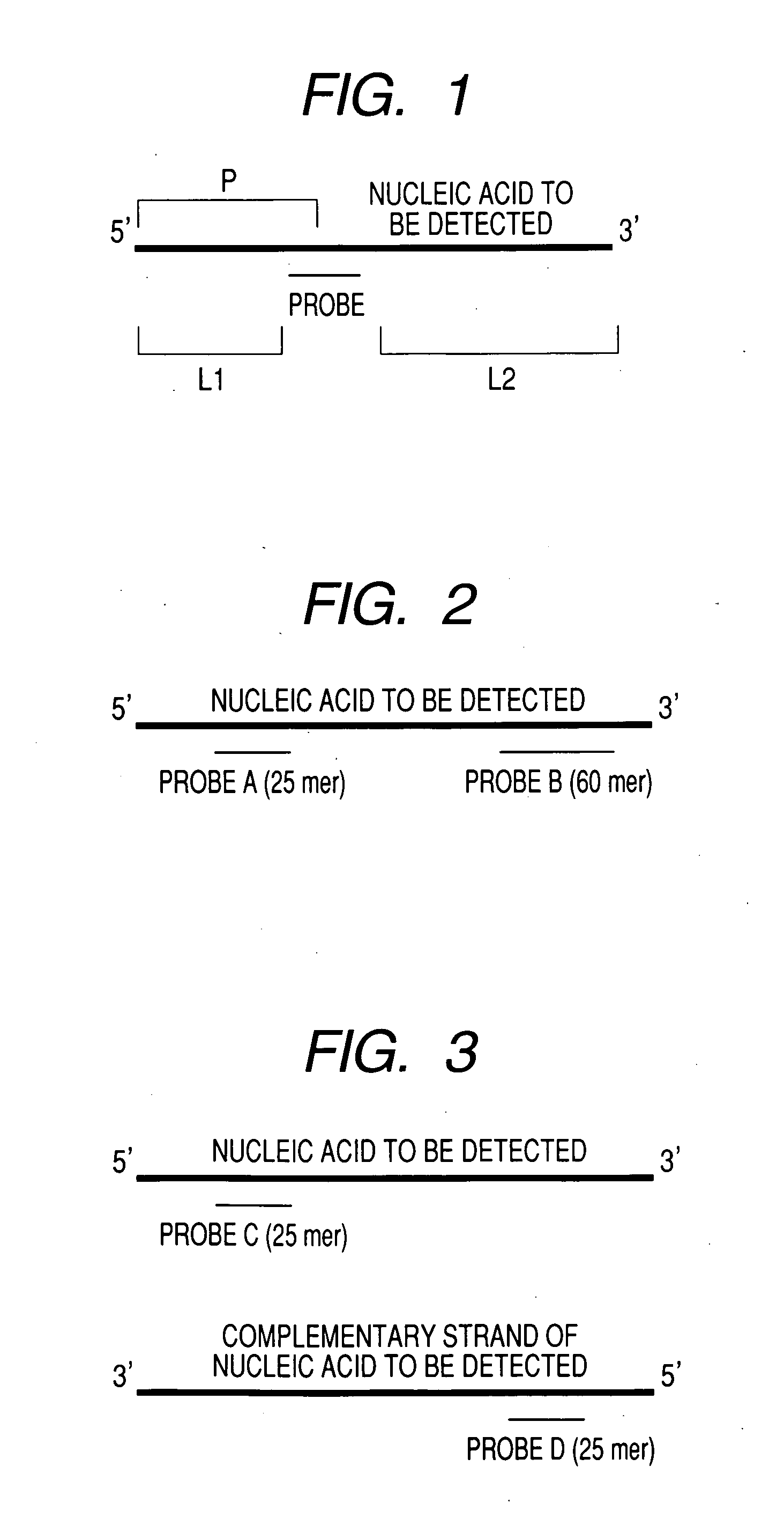Probe set and substrate for detecting nucleic acid
a technology which is applied in the field of probe set and substrate for detecting nucleic acid, can solve the problems of inability to achieve the same level of detection sensitivity for individual hybrids across the nucleic acid to be detected, and alone cannot solve problems, etc., to achieve the and the effect of same level of hybrid stability
- Summary
- Abstract
- Description
- Claims
- Application Information
AI Technical Summary
Benefits of technology
Problems solved by technology
Method used
Image
Examples
example 1
I. PCR of pUC118 EcoRI / BAP
(1) Design of Primer
[0065] A vector pUC118 EcoRI / BAP (a total of 3162 bp in length) commercially available from Takara was selected as a model for a sample having a sequence to be tested. Based on its nucleotide sequence, a total of two types of primers, a forward primer F1 and a reverse primer R1, having sequences described below were designed. Information on the whole nucleotide sequence of pUC118 EcoRI / BAP is provided by Takara and is also available from a public database, etc.
[0066] The primers were designed with consideration given to sequence, GC %, and melting temperature (Tm value) so that the desired partial nucleotide sequence in pUC118 EcoRI / BAP was amplified specifically and efficiently by PCR amplification. The Tm value was calculated on the conditions that: Na+ is 50 mm; Mg2+ is 1.5 mM; and a primer concentration is 0.5 μM.
TABLE 1DesignationSequenceTm valueF15′ TGATTTGGGTGATGGTTCACGTAG 3′63.8° C.R15′ ATCAGCAATAAACCAGCCAGCC 3′64.7° C.
[00...
example 2
(1) Design of Probe
[0088] One type of probe was newly designed for the PCR product 1 synthesized in Example 1. The probe newly designed is a probe that is designed to detect a strand extending from the primer Fl in a portion corresponding to the P1 domain in Example 1. The probe was designed with consideration given to sequence, GC%, and melting temperature (Tm value) so that the probe. can specifically recognize the designed partial nucleotide sequence. The nucleotide sequence and Tm value of the designed probe ate shown in Table 8.
TABLE 8BaseProbelengthSequenceTmP4255′ GCAGATTGTACTGAGAGTGCACCAT 3′76.4
[0089] The values of L1 and L2 are shown in Table 9 as in Example 1.
TABLE 9L1L2P42461053
(2) From Production of DNA Microarray Through Hybridization
[0090] The synthesis of the probe, the production of a DNA microarray, and hybridization using the identical PCR product 1 were performed in the same way as Example 1 except that the probe P3 that was designed and used in Example 1 ...
PUM
| Property | Measurement | Unit |
|---|---|---|
| Temperature | aaaaa | aaaaa |
| Temperature | aaaaa | aaaaa |
| Temperature | aaaaa | aaaaa |
Abstract
Description
Claims
Application Information
 Login to View More
Login to View More - R&D
- Intellectual Property
- Life Sciences
- Materials
- Tech Scout
- Unparalleled Data Quality
- Higher Quality Content
- 60% Fewer Hallucinations
Browse by: Latest US Patents, China's latest patents, Technical Efficacy Thesaurus, Application Domain, Technology Topic, Popular Technical Reports.
© 2025 PatSnap. All rights reserved.Legal|Privacy policy|Modern Slavery Act Transparency Statement|Sitemap|About US| Contact US: help@patsnap.com

